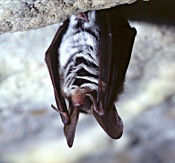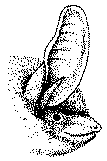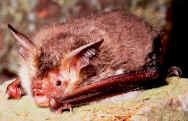Bechstein's
 In the UK Bechstein's bat (Myotis bechsteinii) is very rare, occurring
mainly in Dorset, Wiltshire and Hampshire and is absent from Ireland. A small
number have recently been recorded in Warwickshire. It
is a medium-sized bat with long broad ears.
In the UK Bechstein's bat (Myotis bechsteinii) is very rare, occurring
mainly in Dorset, Wiltshire and Hampshire and is absent from Ireland. A small
number have recently been recorded in Warwickshire. It
is a medium-sized bat with long broad ears.
It seems to be a bat of ancient mature forests because bones found in
some cave deposits show that it was much more common 3,000 to 4,000 years
ago, before Britain's wildwoods were cleared for agriculture.
Ancient woodland is defined as land that has been continuously wooded
for at least 400 years. The bad news is that this type of habitat now
covers just 2% of the UK.
flight & ultrasound
 Emerges
only after nightfall and has a fluttering agile flight high up in the
tree canopy. Its echolocation calls are very quiet and so is very difficult
to pick up with a bat detector at ground level. One tactic used by researchers
from Sussex University on these quiet bats is to play back part of their
call causing them to come and investigate. They can then be caught and
radio-tagged so that their tree roosts can be located.
Emerges
only after nightfall and has a fluttering agile flight high up in the
tree canopy. Its echolocation calls are very quiet and so is very difficult
to pick up with a bat detector at ground level. One tactic used by researchers
from Sussex University on these quiet bats is to play back part of their
call causing them to come and investigate. They can then be caught and
radio-tagged so that their tree roosts can be located.
 Bechstein's call on a Heterodyne bat detector
Bechstein's call on a Heterodyne bat detector
 Bechstein's call on a Time Expansion bat detector
Bechstein's call on a Time Expansion bat detector
breeding
In continental Europe it breeds in bat boxes and has been recorded in
rock hollows.
summer roosts
Since it is a very rare bat, protection of nursery roosts is very important.
It is mainly found in tree holes and rarely in buildings.
winter roosts

Occasionally
found in caves and tunnels, but probably also hibernates in tree holes.
Usually roosts in fairly exposed positions in colder parts (3-7°C) of underground
sites. Usually hangs free with ears held well forward and parallel. Found
in hibernation sites between October and March but mainly in the months
of December and January.
| Description |
|
| Head and Body Length |
45 - 55 mm |
| Forearm Length |
38 - 47 mm |
| Wingspan |
250 - 300 mm |
| Weight |
7 - 14 g |
| Colour |
Pale to reddish brown fur, light grey underneath. |
|
|
| |
|
| Life Cycle |
|
| Mating Period |
Autumn to spring. |
| Maternity Colonies |
From end of April/May. |
| Colony Size |
10 - 30 females.
Young: 1 born end of June to beginning of July. |
| Longevity |
21 years. |
| UK Status |
Rare. |
|
|
| |
|
| Habitat and Food |
|
| Summer Roosts |
Tree holes and larger bat boxes, buildings occasionally. |
| Winter Roosts |
Caves, cellars, mines, tree holes. |
| Feeding Habitat |
Woodland bat. Also found in parks, pine forests, parks
and gardens. |
| Food |
Moths, mosquitoes and beetles. |